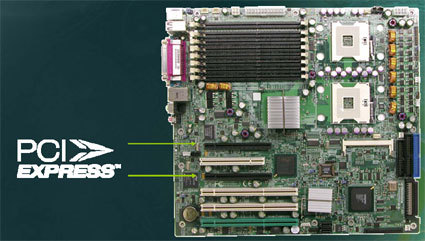NVIDIA Takes a Walk on the SLI Side with Double Graphics Processing
Hardware Requirements
At first glance, the hardware requirements for NVIDIA's SLI Multi-GPU are rather modest. All you need are two GeForce 6800 PCI Express cards, the bridge-connector and a motherboard that comes with two x16 PCI Express slots. However, taking a closer look reveals that there are some details that need to be considered.
Graphics Cards: For Multi-GPU to work, both cards need to be of the same performance class, meaning you can only pair either two GeForce 6800 Ultras, two GeForce 6800 GTs or two GeForce 6800s (standard). Mixing these cards will not work, although it should in theory, due to the dynamic load-balancing capability. Whether NVIDIA will enable SLI in its future mainstream NV4x cards remains to be seen. NVIDIA would not comment on whether it plans to offer SLI-enabled NV4x cards or not.
All GeForce 6800 cards with PCI Express feature the SLI connector.
Motherboard: Obviously, you'll need a motherboard that has two x16 PCI Express slots. The space between these two slots is dictated by the length of the bridge-connector (dual slot). Which motherboards, let alone chipsets, will fulfill these requirements and what types of solutions will come to market is unclear at present. Currently, only Intel's Tumwater workstation chipset seems to be a candidate for a dual graphics solution, although it is unattractive for the mass market because of its high price.
On the other hand, PCI Express has only just been introduced. It is only a matter of time until mainstream chipsets that feature more than one x16 lane see commercialization. An alternative would be to use a switch such as the one IMC Semiconductor has already developed. Finally, since NVIDIA is itself a chipset company, it seems like a safe bet that it will also launch a chipset catering to the requirements of its high-end video cards, i.e. offering a dual-slot solution.
Currently only Tumwater-based server boards offer two x16 PCI Express slots.
V-Sync: It turns out that the fear that V-Sync would need to be enabled during parallel GPU operation is unfounded. NVIDIA has solved this problem by using a buffer to merge the two cards' signals. The danger of seeing tearing in a scene is therefore no greater than when using a single graphics card with V-sync deactivated. This way, the cards can run at the highest possible frame rate without being limited by the monitor's refresh rate.
Get Tom's Hardware's best news and in-depth reviews, straight to your inbox.
Overclocking: Overclocking the card will still be possible through the driver. In this case, both cards will be overclocked to the same level.
Current page: Hardware Requirements
Prev Page NVIDIA SLI Multi-GPU Next Page Hardware Requirements, Continued
